The Nexus 7 (2013) Review
by Anand Lal Shimpi on August 22, 2013 6:00 PM EST
Truth be told, Google has made (or at least directed the making of) some of the best tablets on the market today. The original Nexus 7 was groundbreaking in that it offered a totally usable platform, married to the latest version of Android, for $199. The Nexus 10 gave us a very quick, ultra high resolution 10-inch tablet for $100 less than the flagship iPad (and with more storage). Both were easily recommendable due to their value, but this year Google is stepping out of the shadow of value and into one of excellence. It starts with the new Nexus 7.
Based on the success of the original Nexus 7, Google went back to ASUS for the second version. In the 12 months since the release of the Nexus 7, the world has changed quite a bit. Expectations for value tablets had been reset by the original Nexus 7 as well as Amazon's lineup of Kindle Fires. Simply showing up with another good value likely wouldn't do anything to further the brand (or market). I get the distinct impression that Google isn't big on not changing the world.
| Nexus 7 Tablet Specification Comparison | ||||
| ASUS Nexus 7 (2012) | ASUS Nexus 7 (2013) | |||
| Dimensions | 198.5 x 120 x 10.45mm | 200 x 114 x 8.65mm | ||
| Chassis | Plastic + Rubber back | Plastic + Soft Touch back | ||
| Display | 7-inch 1280x800 IPS | 7.02-inch 1920x1200 IPS | ||
| Weight | 340 g | 290 grams (WiFi), 299 grams (LTE) | ||
| Processor | 1.3 GHz NVIDIA Tegra 3 (T30L - 4 x Cortex A9) | 1.5 GHz Qualcomm Snapdragon S4 Pro (APQ8064-1AA) | ||
| Memory | 1 GB | 2 GB DDR3L | ||
| Storage | 8 GB / 16 GB | 16 GB / 32 GB | ||
| Battery | 16 Whr | 15.01 Whr | ||
| WiFi/Connectivity | 802.11b/g/n, BT, NFC | 802.11a/b/g/n, BT 4.0, NFC | ||
| Camera | 1.2MP Front Facing |
5.0 MP Rear Facing w/AF 1.2MP Front Facing |
||
| Wireless Charging | – | Yes (Qi Compatible) | ||
| Pricing | $199/$249 |
$229/$269 (WiFi 16/32 GB) $349 (LTE) |
||
The result is the new Nexus 7. Identical only in name, manufacturer and screen size, the 2013 Nexus 7 is a downright Apple way to rev a product. Google made it thinner, lighter, faster and better in almost every way.

2013 Nexus 7 (left) vs. 2012 Nexus 7 (right)
The original Nexus 7 was rather thick but it got away with it since the overall footprint of the tablet was so small. The new Nexus 7 truly feels like a slate. It's the type of thing I expect to see carried around on the Enterprise.
I don't miss the rubber imitation leather from the original Nexus 7, it's replaced by a soft touch plastic back. You definitely don't get the premium aluminum feel of the iPad mini, but the device doesn't feel cheap either. The new Nexus 7 is still nice enough that I'm nervous about scratching or scuffing the back.
Both ASUS and Nexus logos are prominently featured on the back. ASUS continues to amaze me by just how far it's come as a company, and the new Nexus 7 is hands down its most impressive tablet creation yet. From a build quality standpoint I really have no complaints about the Nexus 7. While the MeMO Pad HD7 has some creaks and flex in the chassis, the new Nexus 7 feels like a solid slab of soft plastic and glass. It's nice.
Unlike the original Nexus 7, the new model features stereo speakers on back of the tablet. It's an easy feature to take for granted but going back to the old mono design sounds worse.
I agree with Brian that the power/lock and volume buttons are the only real sore spot on the physical execution. They aren't particularly well defined and feel a bit mushy. Even writing this paragraph feels like I'm nit picking though, the build here is really good.
The only other complaint I'd levy against the new Nexus 7 is that the design doesn't particularly stand out as being unique. The iPad has its aluminum, the Moto X has its wood, but the Nexus 7 falls victim to the fact that ultimately it's tough to make these ultra mobile devices stand out. You need a large glass surface and you need a back. Black also tends to be one of the easier colors to sell (get too creative and you end up with inventory problems). It's not a huge deal to me personally, but as mobile devices can often be fashion statements I don't know that the new Nexus 7 has all that much curb appeal.
The Display
What the Nexus 7 lacks in pizazz, it completely makes up for once you power on the display. The 7-inch 1920 x 1200 display produces colors that are not only vibrant but, for the first time ever in a Nexus device, accurate as well. Google really worked on color accuracy this time, with a two step calibration process - once at a high level by the panel maker and once again per device during final manufacturing. The result is just awesome:
The Nexus 7 display is not only visually appealing but stacks up incredibly well in our CalMAN display tests. Although it loses to the iPad 4, the Nexus 7 gets indiscernibly close in many cases and blows the non-Retina iPad mini out of the water. I won't even bother comparing it to everything else in the Android space, they don't hold a candle to it.
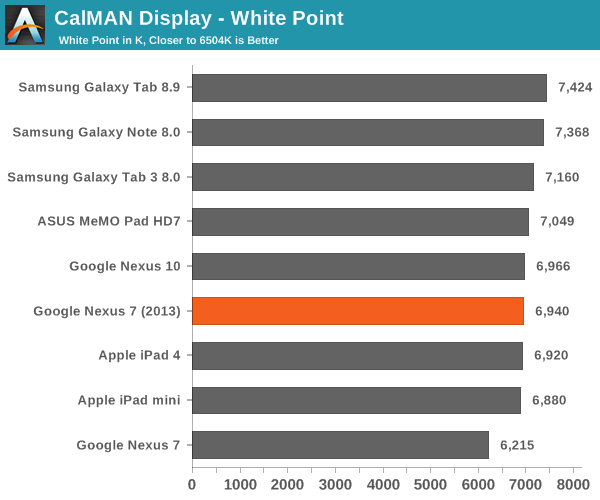
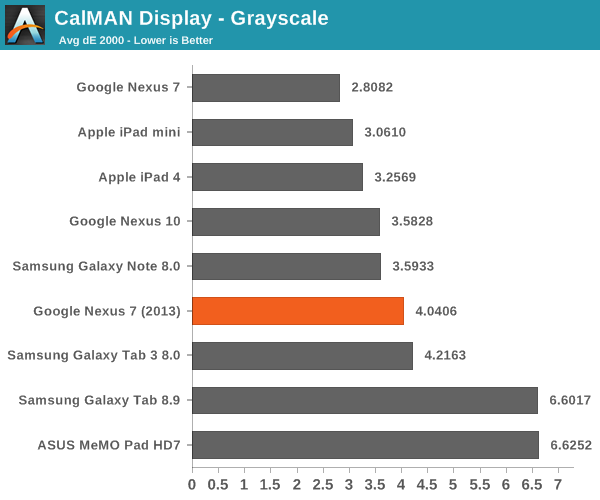
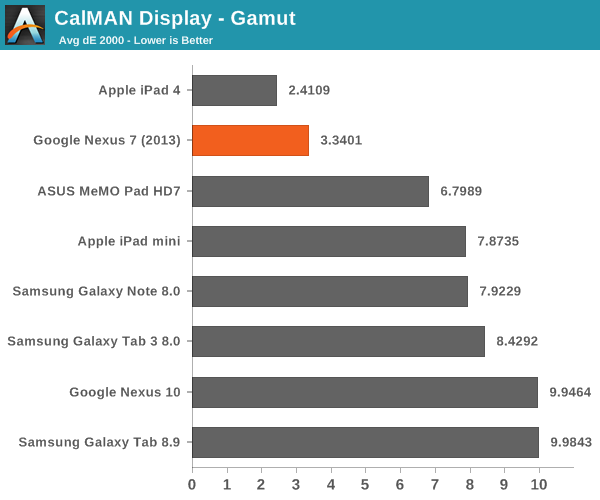
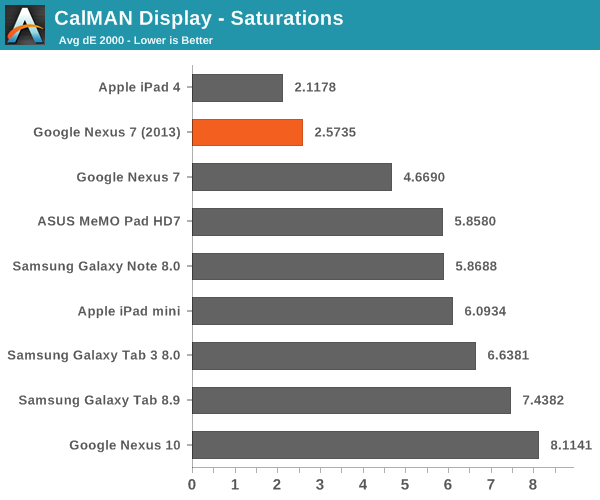
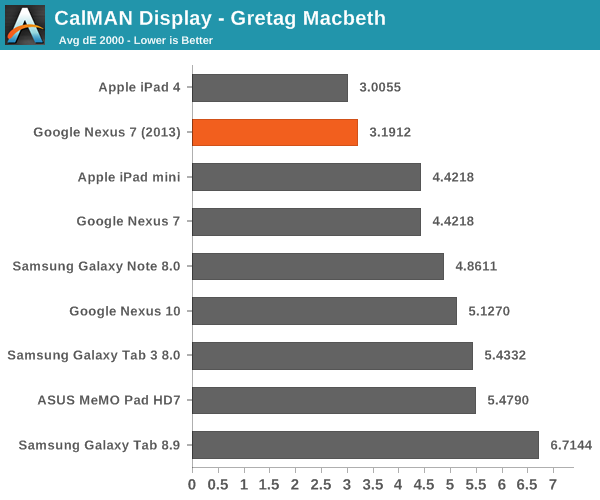
The new panel is also incredibly bright. I typically view 500 nits as the threshold for outdoor usability, and the new Nexus 7 definitely exceeds that threshold. The tablet will drink away all of your battery life if you leave it at this brightness setting indefinitely, but if you need to actually use your tablet outdoors for a while the Nexus 7 works.

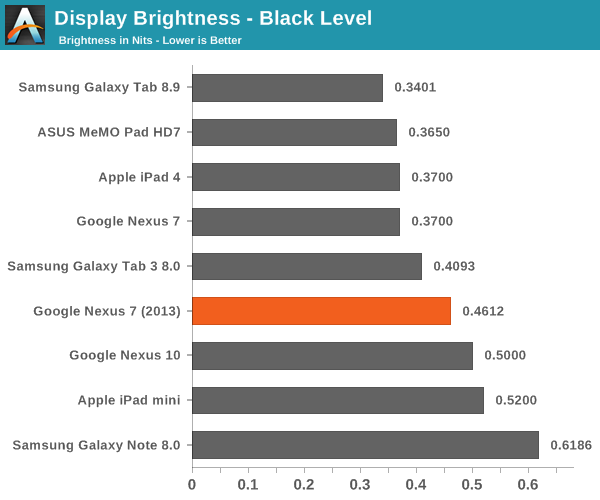
Black levels are a bit higher than on the original Nexus 7, but the resulting peak contrast ratio is still excellent:
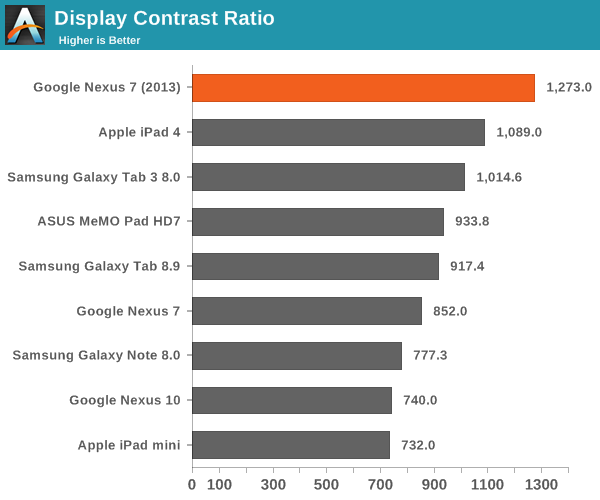
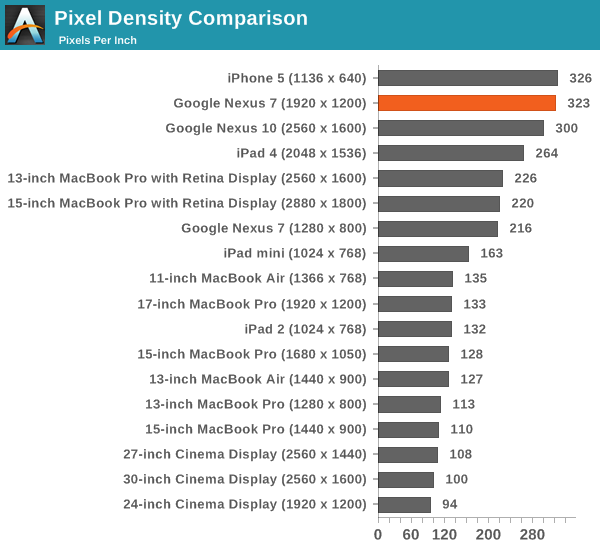
Pixel density shoots through the roof with the new Nexus 7 display as well. Brian was quick to point out that a major advantage of the Android platform is in its flexible resolution handling. The 1920 x 1200 panel presents itself as a 960 x 600 panel to web pages in Chrome, while other apps can use every last pixel for unique content (e.g. games).
The beauty of not having to double the original Nexus 7's resolution but instead settling on an in-between option like 1920 x 1200 is that Google could get away with a performance mainstream SoC instead of something ridiculously high-end.
The display looks great when viewing everything from photos and movies to web pages and eBooks. My only complaint about the Nexus 7's display is its size. A 7-inch tablet is almost pocketable (in fact I did carry it around in my pocket for a day), but the screen can feel a little cramped.


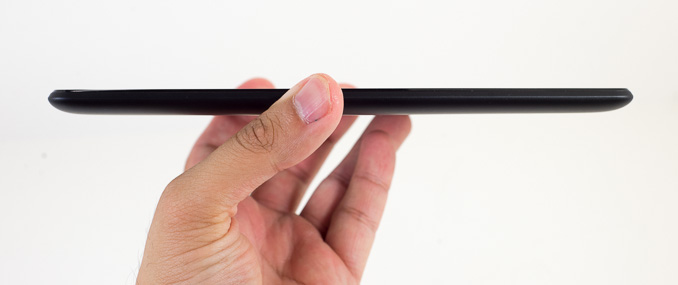
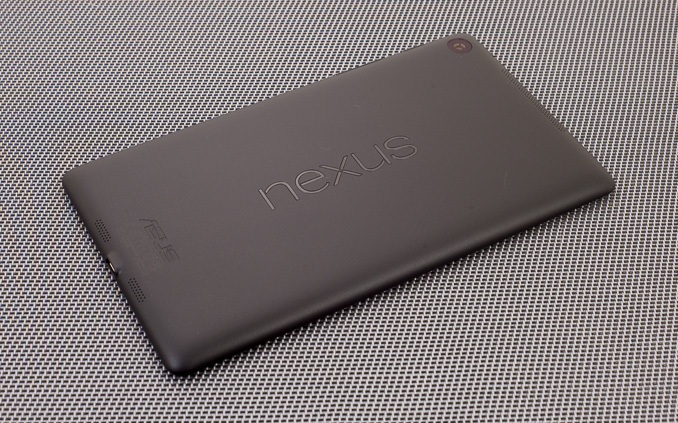
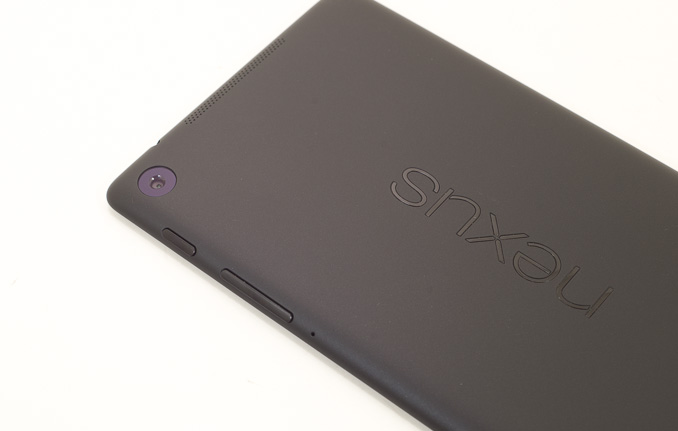


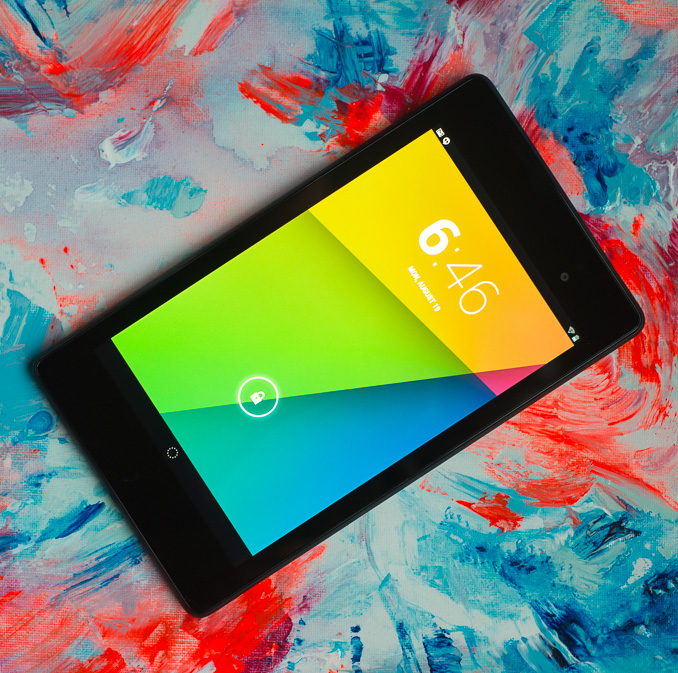
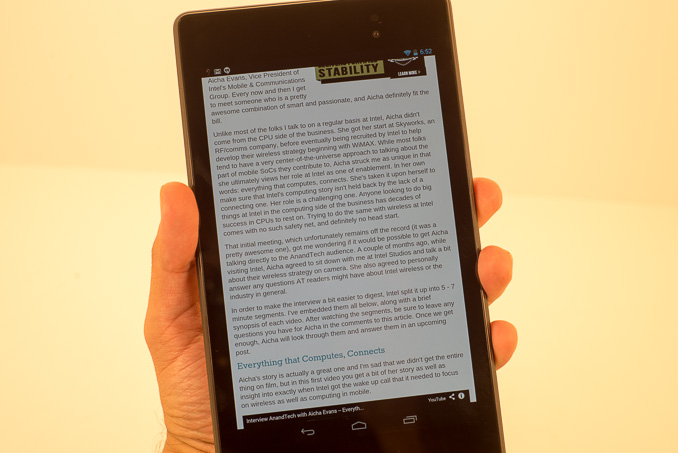
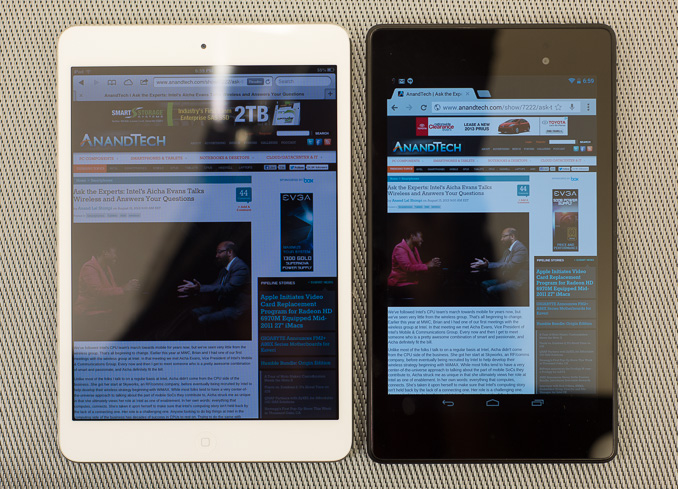








202 Comments
View All Comments
bubblesmoney - Wednesday, September 4, 2013 - link
Learn a bit more about android, quite a bit of what is state is inaccurate. Read all the parts, wanted to leave a comment on the blog but wasnt interested in leaving my email address on your website so didnt bother commenting there. Some simple things you need to know, get rid of the 'anti virus' you dont need it, you can read USB OTG hard drives, wifi drives, dvd players, cameras, wifi camera apps, dslr controller apps, miracast for wireless mirroring (does not need wifi for mirroring, stop comparing to airplay where you need a wifi signal, you dont need an app like you state in the article), nexus media importer can read NTFS hard drives, you can power hard drives with the nexus 7. So read up a bit more about android devices before writing a review as there is so much that is incorrect in the article (all parts) on your website. If you want to see wireless screen mirroring via miracast without using 'apps' or using hard drives etc then just search youtube for such videos or see my youtube channel veryannoyingname where i have uploaded hard drive being powered and read, dvd drive usb otg, etc you can also see some miracast videos so check it out if interested. See the other uploads and numerous playlists to use your android device better. Cheers.jb14 - Thursday, August 22, 2013 - link
Hi Anand thanks for the great review as always.I have a quick question for anyone here - i'm abit puzzled by the first two graphs on page one, ie the CalMAN display white point & Greyscale graphs. Here the Nexus 7 (2013) seems significantly worse than the original Nexus but there is no mention of this, however when the black levels are slightly worse on the new nexus in comparison this is picked up and explained. Am I missing something here or was the original nexus screen really that good in comparison, or do those two graphs have the nexus results the wrong way round so to speak? Are the differences too small to warrant highlighting? Thanks
darwinosx - Thursday, August 22, 2013 - link
Not a word about the fact that these are sold at cost.I have bought three of these as gifts but a retina iPad Mini will be a much better device when it arrives next month. 35 to 40% more screen real estate and real tablet apps instead of upsized apps plus three choices of memory sizes and LTE. This screen is too small for me though. Also the buttons are terrible.
sherlockwing - Thursday, August 22, 2013 - link
For 16:9 content, a 7.9" 4:3 screen only give you 13% more space. In exchange the Mini is almost an inch wider than N7 2013 while having much less bezel, not to mention Mini2 will end up being much more expensive than N7 2013 just like how N7 2012 vastly under priced the original mini.madmilk - Thursday, August 22, 2013 - link
I don't understand why people criticize the Nexus 4 and Nexus 7 for being sold nearly at cost. Are you really so eager to help Google, Apple, etc. make money? I'd prefer to keep it in my own pocket.BMNify - Thursday, August 22, 2013 - link
If subsidised hardware kill off the hardware manufacturer's then you will be left with a monopoly that is Google who can charge you more later and make money on Ad's too like they do now. This is the reason why selling at-cost or dumping is not desirable.sherlockwing - Thursday, August 22, 2013 - link
The sold at cost N7 is competing with the sold below cost Kindle Fire. The console market have the sold below cost Xbox competing with the sold below cost Playstation. Your logic doesn't work out in practice.BMNify - Thursday, August 22, 2013 - link
I have covered Amazon strategy in the below comments and console market is the perfect example of what will happen if all OS manufacturer's start dumping their hardware in the market. And console market is a much much smaller market where even 2-3 companies are enough but smartphones, tablets and laptops market is a very huge which needs healthy competition and many manufacturers to support all price points, device differentiation and quality.smartypnt4 - Thursday, August 22, 2013 - link
And? What's your point? How is it a negative that these are sold nearer to cost than Apple's 40%+ margin?Mivo - Friday, August 23, 2013 - link
End customers don't care if a device is sold at cost. I don't consider a low price a negative. The retina iPad mini won't be out next month, which is one of the main reasons why I now pre-ordered a N7 (hitting German shelves next week). I waited long enough.